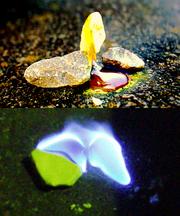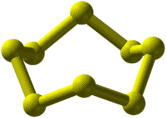 SULPHUR
SULPHUR
| 16 | phosphorus ← sulfur → chlorine |
O
↑
S
↓
Se |

Periodic Table | Extended Periodic Table |
| General |
| Name, Symbol, Number |
sulfur, S, 16 |
| Chemical Series |
nonmetals |
| Group, Period, Block |
16, 3, p |
| Appearance |
lemon yellow
 |
| Standard atomic weight |
32.065(5)mg.mol-1 |
| Electronic configuration |
[Ne]3s23p4 |
| Electrons per shell |
2, 8, 6 |
| Physical Properties |
| Phase |
Solid |
| Density (near r.t.) |
(alpha) 2.07 g.cm-3 |
| Density (near r.t.) |
(beta) 1.96 g.cm-3 |
| Density (near r.t.) |
(gamma) 1.92 g.cm-3 |
| Liquid density at m.p. |
1.819 g.cm-3 |
| Melting point |
388.36 K (115.21 °C, 239.38 °F) |
| Boiling point |
717.8 K (444.6 °C, 832.3 °F) |
| Critical point |
1314 K, 20.7 MPa |
| Heat of fusion |
(mono) 1.727 kJ.mol-1 |
| Heat of vaporization |
(mono) 45 kJ.mol-1 |
| Heat capacity |
(25 °C) 22.75 J.mol-1.K-1 |
Vapor Pressure
| P/Pa | 1 | 10 | 100 | 1k | 10k | 100k |
| at T/K | 375 | 408 | 449 | 508 | 591 | 717 |
|
| Atomic Properties |
| Crystal structure |
orthorhombic |
| Oxidation states |
-1, ±2, 4, 6 (strongly acidic oxide) |
| Electronegativity |
2.58 (Pauling scale) |
| Ionization energies (more) |
1st: 999.6 kJ.mol-1
2nd: 2252 kJ.mol-1
3rd: 3357 kJ.mol-1 |
| Atomic radius |
100 pm |
| Atomic radius (calc) |
88 pm |
| Covalent radius |
102 pm |
| Van der Waals radius |
180 pm |
| Miscellaneous |
| Magnetic ordering |
no data |
| Electrical resistivity |
(20 °C) (amorphous) 2 x 1015Ω.m |
| Thermal conductivity |
(300 K) (amorphous) 0.205 W.m-1.K-1 |
| Bulk modulus |
7.7 GPa |
| Mohs hardness |
2.0 |
| CAS registry number |
7704-34-9 |
| Selected isotopes |
Main article: Isotopes of sulfur
| iso | NA | half-life | DM | DE (MeV) | DP |
| 32S | 95.02% | S is stable with 16 neutrons |
| 33S | 0.75% | S is stable with 17 neutrons |
| 34S | 4.21% | S is stable with 18 neutrons |
| 35S | syn | 87.32 d | β- | 0.167 | 35C| |
| 36S | 0.02% | S is stable with 20 neutrons |
|
Sulfur or sulphur (IPA: θεíov, see spelling below) is the chemical element that has the symbol S and atomic number 16. It is an abundant, tasteless, multivalent non-metal. Sulfur, in its native form, is a yellow crystalline solid. In nature, it can be found as the pure element or as sulfide and sulfate minerals. It is an essential element for life and is found in two amino acids, cysteine and methionine. Its commercial uses are primarily in fertilizers, but it is also widely used in gunpowder, matches, insecticides and fungicides.
Sulfur melts to a blood-red liquid. When burned, it emits a blue flame.

At room temperature, sulfur is a soft bright yellow solid. Elemental sulfur has only a faint odor similar to that of matches. The odor associated with rotten eggs is from hydrogen sulfide (H2S) and organic sulfur compounds. Sulfur burns with a blue flame that emits sulfur dioxide, notable for its peculiar suffocating odor. Sulfur is insoluble in water but soluble in carbon disulfide and to a lesser extent in other nonpolar organic solvents such as benzene and toluene. Common oxidation states of sulfur include -2, +2, +4 and +6. Sulfur forms stable compounds with all elements except the noble gases. Sulfur in the solid state ordinarily exists as cyclic crown-shaped S8 molecules. Sulfur has many allotropes besides S8. Removing one atom from the crown gives S7, which is responsible for sulfur's distinctive yellow color. Many other rings have been prepared, including S12 and S18. By contrast, its lighter neighbor oxygen only exists in two states of allotropic significance: O2 and O3. Selenium, the heavier analogue of sulfur can form rings but is more often found as a polymer chain.
 The structure of the cyclooctasulfur molecule, S8
The structure of the cyclooctasulfur molecule, S8
The crystallography of sulfur is complex. Depending on the specific conditions, the sulfur allotropes form several distinct crystal structures, with rhombic and monoclinic S8 best known
A noteworthy property of sulfur is that its viscosity in its molten state, unlike most other liquids, increases above temperatures of 200°C due to the formation of polymer chains. The molten sulfur also becomes dark red in colour above this temperature due to the presence of free valences on terminal atoms of the polymer chains. However, after a specific temperature is reached, the viscosity is reduced because there is enough energy to break the chains.
Amorphous or "plastic" sulfur can be produced through the rapid cooling of molten sulfur. X-ray crystallography studies show that the amorphous form may have a helical structure with eight atoms per turn. This form is metastable at room temperature and gradually reverts back to crystalline form. This process happens within a matter of hours to days but can be rapidly catalyzed.
In the late 1700s, furniture makers used molten sulfur to produce decorative inlays in their craft. Because of the sulfur dioxide produced during the process of melting sulfur, the craft of sulfur inlays was soon abandoned. Molten sulfur is sometimes still used for setting steel bolts into drilled concrete holes where high shock resistance is desired for floor-mounted equipment attachment points. Pure powdered sulfur was also used as a medicinal tonic and laxative.
Sulfur has many modern industrial uses. Through its major derivative, sulfuric acid (H2SO4), sulfur ranks as one of the most important industrial raw materials. It is of prime importance to every sector of the world's economies.
Sulfuric acid production is the major route in industrial sulfur chemistry on the way to many end-uses, and production and consumption of sulfuric acid has been regarded as one of the best indices of a nation's industrial development. [1]. For example, more sulfuric acid is produced in the United States every year than any other industrial chemical; although interestingly the rate of increase of U.S. production has encountered shocks since the mid 1960's, mirroring U.S. loss of industrial post-World War II world influence. Principal uses for the acid include ore processing, fertilizer manufacturing, oil refining, wastewater processing, and chemical synthesis.
Sulfur is also used in batteries, detergents, the vulcanization of rubber, fungicides, ie skin care soaps, and in the manufacture of phosphate fertilizers. Sulfites are used to bleach paper and as a preservative in wine and dried fruit. Because of its flammable nature, sulfur also finds use in matches, gunpowder, and fireworks. Sodium or ammonium thiosulfate is used as photographic fixing agents. Magnesium sulfate, better known as Epsom salts, can be used as a laxative, a bath additive, an exfoliant, a magnesium supplement for plants, or a desiccant. Sulfur is used as a light-generating medium in the rare lighting fixtures known as sulfur lamps. Elemental sulfur crystals are commonly sought after by rock collectors for their brightly colored polyhedron shapes.
Sulfur is an essential component of all living cells.
Sulfur may also serve as chemical food source for some primitive organisms: some forms of bacteria use hydrogen sulfide (H2S) in the place of water as the electron donor in a primitive photosynthesis-like process. Inorganic sulfur forms a part of iron-sulfur clusters, and sulfur is the bridging ligand in the CuA site of cytochrome c oxidase, a basic substance involved in utilization of oxygen by all aerobic life.
Sulfur is absorbed by plants via the roots from soil as the sulfate ion and reduced to sulfide before it is incorporated into cysteine and other organic sulfur compounds (sulfur assimilation).
In plants and animals the amino acids cysteine and methionine contain sulfur, as do all polypeptides, proteins, and enzymes which contain these amino acids. Homocysteine and taurine are other sulfur-containing acids which are similar in structure, but which are not coded for by DNA, and are not part of the primary structure of proteins. Glutathione is an important sulfur-containing tripeptide which plays a role in cells as a source of chemical reduction potential in the cell, through its sulfhydryl (-SH) moiety. Many important cellular enzymes use prosthetic groups ending with -SH moieties to handle reactions involving acyl-containing biochemicals: two common examples from basic metabolism are coenzyme A and alpha-lipoic acid.
Disulfide bonds (S-S bonds) formed between cysteine residues in peptide chains are very important in protein assembly and structure. These strong covalent bonds between peptide chains give proteins a great deal of extra toughness and resiliancy. For example, the high strength of feathers and hair is in part due to their high content of S-S bonds and their high content of cysteine and sulfur (eggs are high in sulfur because large amounts of the element are necessary for feather formation). The high disulfide content of hair and feathers also contributes to their indigestibility, and also their smelly odor when burned.
The burning of coal and/or petroleum by industry and power plants creates massive amounts of sulfur dioxide (SO2) which reacts with atmospheric water and oxygen to produce sulfuric acid (H2SO4). This sulfuric acid is a component of acid rain, which lowers the pH of soil and freshwater bodies, resulting in substantial damage to the natural environment and chemical weathering of statues and structures. Fuel standards increasingly require sulfur to be extracted from fossil fuels to prevent the formation of acid rain. This extracted sulfur is then refined and represents a large portion of sulfur production.
Carbon disulfide, carbon oxysulfide, hydrogen sulfide, and sulfur dioxide should all be handled with care.
Although sulfur dioxide is sufficiently safe to be used as a food additive in small amounts, at high concentrations it reacts with moisture to form sulfurous acid which in sufficient quantities may harm the lungs, eyes or other tissues. In organisms without lungs such as insects or plants, it otherwise prevents respiration.
Hydrogen sulfide is quite toxic (more toxic than cyanide).[citation needed] Although very pungent at first, it quickly deadens the sense of smell, so potential victims may be unaware of its presence until it is too late.
The element has traditionally been spelled sulphur in the United Kingdom, Ireland, Hong Kong, the Commonwealth Caribbean and India, but sulfur in the United States, while both spellings are used in Australia, Canada and New Zealand. IUPAC adopted the spelling “sulfur” in 1990, as did the Royal Society of Chemistry Nomenclature Committee in 1992.[citation needed] The spelling of the term in non-official texts is gradually becoming uniform as sulfur.
The Latin name of the element is sulfur with an F. Since it is an original Latin name and not a Classical Greek loan, the fricative phoneme is indeed denoted with f rather than ph (which would denote the Greek letter φ). Sulfur in Greek is theion (θεíov), whence comes the prefix thio-
For further clarification, please feel free to contact us.
 BACK TO PRODUCTS
BACK TO PRODUCTS





